p.589
p.593
p.598
p.604
p.611
p.617
p.621
p.625
p.630
A Power Optimization Algorithm for Ad Hoc Networks with Variable Rate Control
Abstract:
This paper is concerned with the capacity of ad hoc networks employing pure ALOHA medium access control (MAC) protocol under the effect of different transmission power levels and variable data rate control. The data rate of a certain link is related to the signal to interference plus noise ratio (SINR), and SINR is, in turn, related to the transmitted power and link distance. The increasing power conducts a high data rate, resulting in the high interference of networks. Consequently, the optimum power that yields maximum network throughput is a tradeoff between transmission rate and network interference. Mathematical model analysis for the ad hoc network capacity are presented in the paper. A revised expression to the approximate calculating of the capture probability in networks is proposed.
Info:
Periodical:
Pages:
611-616
Citation:
Online since:
December 2013
Authors:
Price:
Сopyright:
© 2014 Trans Tech Publications Ltd. All Rights Reserved
Share:
Citation:


